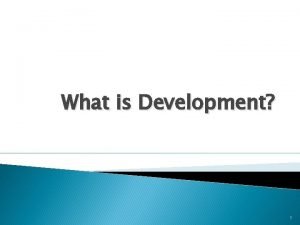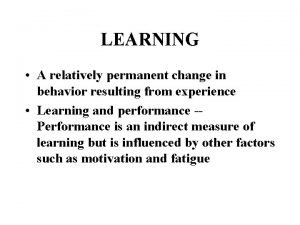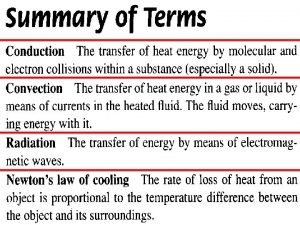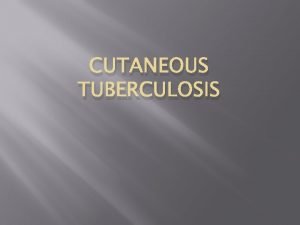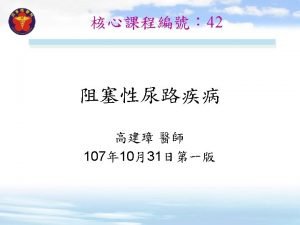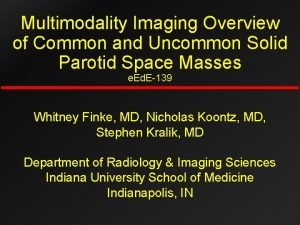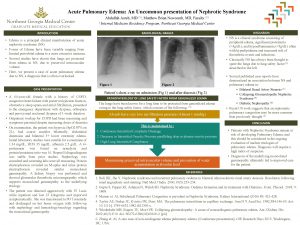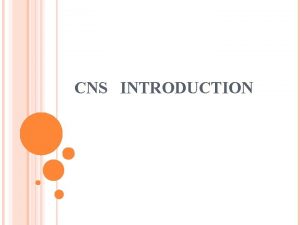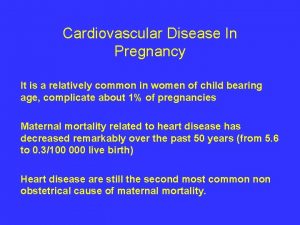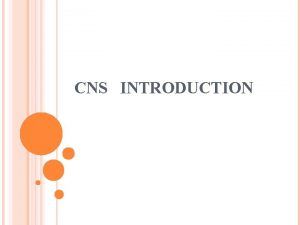Common presentation of a relatively Uncommon disease An




















- Slides: 20

Common presentation of a relatively Uncommon disease. An unusual case of Fever. Dr. Shubham Malani. Department of Medicine Dr. D. Y. Patil Medical College.

• A 24 year old male, student, came with c/o • Fever moderate to high grade since 1 month • Progressive breathlessness since 1 month which has worsened since 3 days • Generalized weakness and fatigability • There was no history of cough, chest pain, vomiting, bleeding manifestations or any other complaints.

• PAST HISTORY : • Patient had history of similar episode of Anemia with jaundice and fever admitted twice in last year, details of which were unavailable. • PERSONAL HISTORY : • Appetite was reduced. • Sleep was reduced. • Vegetarian by diet. • Bladder & bowel were unaltered. • No addictions.

On Examination: • The patient was drowsy but oriented. • Severe pallor and icterus was present. • Febrile, Temperature – 103 o. F • PR : 108/min • RR : 40 /min • BP : 110 / 70 mmhg • SPO 2 was low. 76% on oxygen enriched room air. • JVP was raised upto the angle of jaw. • Clubbing grade II present. • Bilateral Pitting Pedal edema was present.

• CNS : Drowsy but oriented. No focal neurological deficit. Plantars- Flexor. • RS : Tachypnoea with B/l basal crepitations were present. • P/A : Soft , Mild hepatosplenomegaly. • CVS : Tachycardia was present. No S 3/S 4/murmur. • Chest Xray showed bilateral fluffy shadows. • ECG suggestive of sinus tachycardia. • In view of above findings & as patient was unable to maintain saturation on oxygen , he was intubated.

Chest Xray showing B/L Fluffy Shadows s/o Pulmonary edema.

ECG showing Sinus Tachycardia.

Investigations Hb 2. 2 gm% (13. 3 -16. 2) Urea 55 (16 -48) TLC 4700 Creatinine 0. 84 PLT 36000 (1. 5 L-4. 5 L) Total bilirubin 7. 4 (0 -1. 4) MCV 115. 5 (79 -93. 3) Direct 1. 4 HCT 6. 7(38. 8 -46. 4) Indirect 6. 06 (0 -0. 9) MCH 37. 93 SGPT 445 (0 -40) MCHC 32. 8 SGOT 729 (0 -40) LDH 2838 (115 -221) Serum electrolytes WNL • PBS showed Macrocytes, Microcytes, Hypochromasia. • Retic count- 1% • Urine examinations showed 20 -30 RBCs/hpf. • Above investigations were suggestive of Acute hemolysis with Megaloblastic anemia.

WORKING DIAGNOSIS • In view of history and investigations our provisional diagnosis was. Fever with Congestive cardiac failure with pulmonary oedema due to severe anemia and jaundice with differentials being – • Complicated Malaria. • Salmonellosis • Leptospirosis

Treatment (Day 1) • 2 PCV were given immediately. • Inj. Furosemide 20 mg IV with BP monitoring was given. • Inj. Ceftriaxone 1 gm IV BD. • Inj. Artesunate 120 mg stat f/b 60 mg BD was started. • Tab. Paracetamol 500 mg TDS.

Day 2 -3 • The patient improved post BT. • But the fever continued. • Patient was further evaluated. • Investigations : • PT-INR was raised(1. 8). • Rapid malaria test and PBS for malarial parasite was negative. • Dengue NS 1, Ig. M, Ig. G (by elisa)was also negative. • Widal test & Leptospira was also negative. • Blood and urine cultures were awaited.

• USG abdomen : Was suggestive of mild hepatosplenomegaly, mild ascites, mild pleural effusion. • With presentation of pallor, clubbing, splenomegaly and high grade fever- A possibility of Infective endocarditis was also thought of. • 2 D echo showed mild global hypokinesia and thin rim of pericardial effusion with EF of 60%. • Transesophageal & transthoracic echocardiography showed no vegetations • Fundoscopy – Roth’s spots, Flame shaped hemorrhages, Cotton wool spots, tortuous blood vessels suggestive of Septic systemic embolization due to Infective endocarditis.

• • • Hematology reference was done : Pancytopenia under evaluation Adv - Direct and Indirect coombs test, ANA. Further Investigations. Sickling test – negative. Direct and Indirect coombs test – negative. ANA - negative. Serum B 12 - 97. 9 pg/ml ( 191 -663 pg/ml) Folic acid - 1. 4 ng/ml ( 4. 6 – 34. 8 ng/ml ) Further Treatment. Inj. Hydroxycobalamin 1000 mcg OD for 6 days followed by once 3 monthly. • Tab Folic acid 5 mg OD

The following day (Day 4 -5) • Congestive cardiac failure and hematocrit was improving. • The consciousness and general condition of the patient was getting better. • Patient was weaned off the ventilator. • Further PCV and FFP was given. • Fever however continued , thus evaluating further ….

• OGDoscopy showed antral gastritis. • Bone marrow aspiration - Erythroid hyperplasia with dual maturation (Megaloblastic and micronormoblastic) • Urine culture showed no growth • Blood culture showed no growth • Bone marrow culture also was negative.

• Despite of all the measures fever still continued and no cause was found. • Then on recording further history It was found that patient had history of consumption of unpasteurized raw milk and contact with cattle for more than 1 year. • Following which Brucella antibody was sent and Ig. M antibody was found to be strongly positive (1. 35). Brucellosis induced Acute Hemolysis with Vit. B 12 and Folic acid deficiency with Infective Endocarditis.

Treatment • Tab. Rifampicin 600 mg OD for 6 weeks • Tab. Doxycycline 100 mg BD for 6 weeks • Following this treatment Patient recovered and is now doing well and came for follow-up after 1 month with repeat antibody titre positive. He was advised to continue the same treatment. After 3 months his repeat Antibody titre is Negative.

Discussion. • Human brucellosis is a zoonosis usually associated with occupational or domestic exposure to infected animals or their products. • The incubation period varies from 1 week to 3 months. • According to a study 14% of patients with brucellosis can present with Pancytopenia. • Brucellosis induced acute hemolysis due to Vit. B 12 and folic acid deficiency presents as Pancytopenia and is a rare presentation of Brucellosis.

Take home message. • As brucellosis is common in our country, and pancytopenia is a common presentation, it should be included in the differential diagnosis of all those clinical conditions presenting as Fever with Pancytopenia.

References • Brucellosis induced acute hemolytic anemia in a severe vitamin b 12 deficient individual presenting as pancytopenia: a case report ; 2018 ; Mathi Manoj Kumar R and Subramony H ; Department of General Medicine, Apollo Hospital, Chennai. • Hematological Findings in adult with brucellosis ; Aypak A, et al. Pediatr Int. 2015.
 Uncommon ion effect
Uncommon ion effect Elikem kuenyehia
Elikem kuenyehia Uncommon logic digital
Uncommon logic digital Communicable disease and non communicable disease
Communicable disease and non communicable disease Greatest common factor of 20 and 36
Greatest common factor of 20 and 36 Common anode and common cathode
Common anode and common cathode Lowest common multiple factor tree
Lowest common multiple factor tree Factors of 54
Factors of 54 Lcm of 10 and 18
Lcm of 10 and 18 Highest common factors and lowest common multiples
Highest common factors and lowest common multiples Occipital brow presentation
Occipital brow presentation Vertex presentation and cephalic presentation
Vertex presentation and cephalic presentation Orderly and concise personality
Orderly and concise personality Remedial teaching is a
Remedial teaching is a The unique and relatively stable ways in which
The unique and relatively stable ways in which Meaning of relatively permanent
Meaning of relatively permanent Douglas merritte
Douglas merritte Learning is any relatively permanent change
Learning is any relatively permanent change Learning is relatively permanent change
Learning is relatively permanent change Are complex relatively brief responses
Are complex relatively brief responses Objects that radiate relatively well
Objects that radiate relatively well












